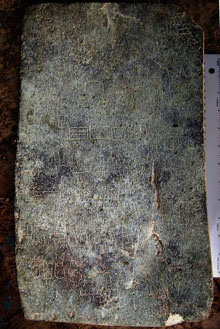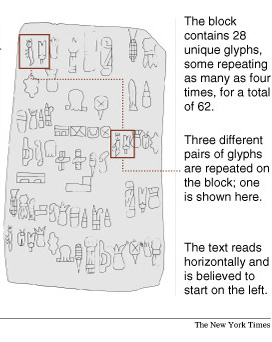 |
 |
 |
 News Around the Republic of Mexico | September 2006 News Around the Republic of Mexico | September 2006  
Mexican Stone Block Rewrites History of Writing
 CBC Arts CBC Arts


| | A stone discovered in Veracruz, Mexico, has the earliest form of text in the Americas, according to research to be published in the journal Science. (AP) |
It could be the New World's first poem, as well as its earliest example of writing of any kind.

The Cascajal block, which was found by road builders near Veracruz, Mexico, may have the New World's first writing.

And careful study of the previously unknown system of writing shows it has paired sequences of signs that could be poetic couplets, according to a release from Brown University on Thursday.

The writing, on what is known as the Cascajal block, was found by road builders in a pile of debris in the community of Lomas de Tacamichapa, Mexico, in the late 1990s.

Mexican archeologists Carmen Rodríguez and Ponciano Ortiz, lead authors of the article in Science, were the first to recognize the importance of the find and also have studied ceramic and stone fragments found nearby.

An international team of archeologists, including Stephen D. Houston of Brown University, dated the block to about 900 B.C.

They believe it came from the Olmec civilization of Mesoamerica, an early civilization centred around the Gulf of Mexico that predates the Maya.

The Olmec were not previously known to be literate. But this block could be evidence that they developed the skill 400 years before writing was known to have developed anywhere in the Americas.

"It's a tantalizing discovery. I think it could be the beginning of a new era of focus on Olmec civilization," said Houston, who is an expert on ancient writing systems.

"It's telling us that these records probably exist and that many remain to be found. If we can decode their content, these earliest voices of Mesoamerican civilization will speak to us today."

In a development Houston calls "unprecedented," the block appears to have been carved repeatedly and erased.

The 26-pound block is carved of the mineral serpentine, and measures, in centimetres, 36x21x13.

The carved script consists of 62 signs, some of which are repeated up to four times.

The text "conforms to all expectations of writing," the team of archeologists say in their research.

| 
 | |
 |



